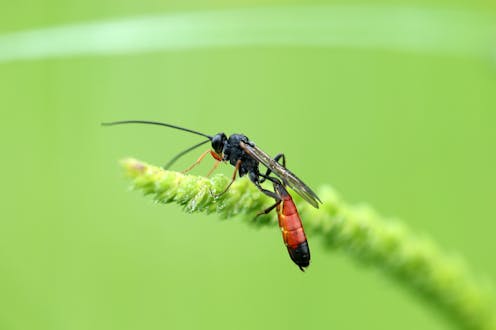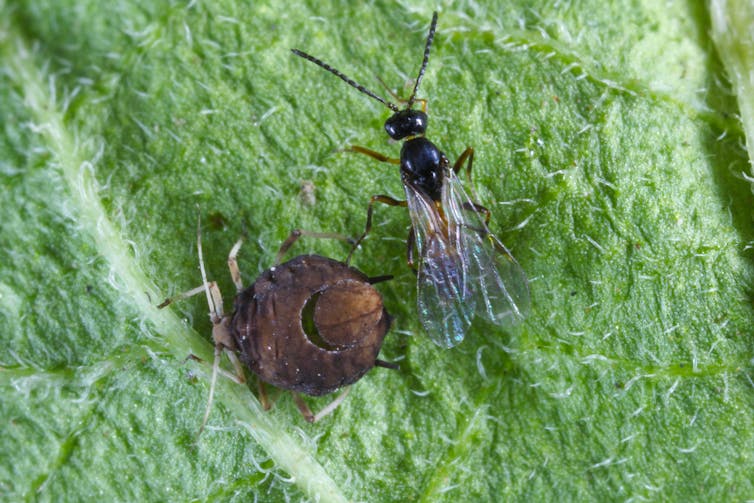
When Charles Darwin first encountered parasitoid wasps, he was horrified. In an 1860 letter to American botanist Asa Gray, he wrote: “I cannot persuade myself that a beneficent and omnipotent God would have designedly created parasitic wasps with the express intention of their feeding within the living bodies of caterpillars.”
The wasps that Darwin encountered were ichneumon wasps, now also known as Darwin wasps, and it is believed that they greatly influenced the way Darwin thought about nature.
A century later, in 1979, the sci-fi horror film Alien was released, featuring a xenomorph, an extraterrestrial creature that parasitizes humans. According to Dan O'Bannon, who wrote the story the film was based on and co-wrote the screenplay, parasitoid wasps and their life cycle were the inspiration behind the alien.
In 2018, scientists from Australia returned the love, and named a new species of parasitoid wasps Dolichogenidea xenomorph, after the alien.
Predators and parasites
To most people, parasitoid wasps are invisible. Their life cycles are quite remarkable, yet they remain almost unknown outside the world of hymenopterists, entomologists who study wasps, as well as ants, bees and other members of the Hymenoptera order.
Parasitoid wasps require a host to finish their development. They are a cross between parasites and predators: like parasites, they feed on their host, and like predators, they ultimately kill it.
Different groups of parasitoid wasps attack different groups of hosts. Wasps in the subfamily Aphidiinae feed exclusively on aphids. Aphids can decrease crop yields and spread plant viruses, necessitating the use of harmful pesticides. Since the host meets its demise after an encounter with a parasitoid, these wasps are used for biological control, and help naturally control aphid populations.

Classification
Biological control only works if we know what we’re controlling and what we’re controlling it with. Taxonomists, like my colleagues and myself, examine insects (in my case, aphids and their parasitoids) and classify them into species.
Taxonomy of living things relies mostly on their morphology. We still use this method heavily, dissecting these tiny insects and looking at them under a microscope to find differences or similarities and figure out which species we’re looking at. When you’re working with one to two millimetre long creatures, this can be daunting.
Technologies like DNA barcoding, devised by biologist Paul Hebert, and DNA sequencing methods, especially next generation sequencing have accelerated this work. Now, I can get a wasp’s DNA and figure out which species it belongs to without having to visually examine the specimen.
To do that, we need a comprehensive reference library of DNA sequences, which is a huge and ongoing task. In online databases containing reference sequences some groups are better represented than others. Ideally, I would use both morphological and molecular data in my work and avoid any misidentifications.
Wasp diversity
Parasitoid wasps seem to be more diverse than assumed. Beetles have long been the “official” insect order, with the highest number of species. However, Hymenoptera (wasps, bees, sawflies, and ants) are actually more species-rich, with huge numbers of cryptic and still unknown species.
Ants often help protect aphids from predators and parasitoids, and collect honeydew from them in return. Ladybugs are voracious predators of aphids, and can also be used in biological control. They are also the bane of hymenopterists, because they will eat aphids, parasitoid larva and all.

A parasitized aphid is called a mummy, and it’s basically a parasitoid wasp larva or pupa developing in a dead aphid skin. In the next stage, the adult wasp will emerge and go about its business of eating, mating, and if it’s a female wasp, finding new hosts to lay her eggs and start the cycle all over again.
Cryptic species
Cryptic species look very similar or identical to other species, but when their DNA is sequenced, there are clear differences in certain genes that indicate there are three or five species instead of one. Identifying species correctly is necessary for proper conservation efforts.
Additionally, correct identification of species is essential for applied fields, like biological control. Closely related and morphologically indistinguishable species of biocontrol agents can have different host requirements, and as a consequence, won’t be effective in controlling the same pests.
It seems that the importance of biodiversity is finally becoming clear to a wider audience beyond scientists, which is great news. Since much of our planet’s biodiversity still remains hidden, we need to describe as many species as we can, as soon as we can, to be able to protect them in time.
Jelisaveta Ckrkic does not work for, consult, own shares in or receive funding from any company or organisation that would benefit from this article, and has disclosed no relevant affiliations beyond their academic appointment.
This article was originally published on The Conversation. Read the original article.







